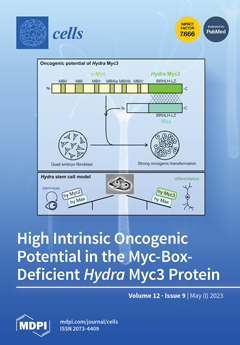The metabotropic glutamate receptor 1 (mGlu
1) plays a pivotal role in synaptic transmission and neuronal plasticity. Despite the fact that several interacting proteins involved in the mGlu
1 subcellular trafficking and intracellular transduction mechanisms have been identified, the protein network associated
[...] Read more.
The metabotropic glutamate receptor 1 (mGlu
1) plays a pivotal role in synaptic transmission and neuronal plasticity. Despite the fact that several interacting proteins involved in the mGlu
1 subcellular trafficking and intracellular transduction mechanisms have been identified, the protein network associated with this receptor in specific brain areas remains largely unknown. To identify novel mGlu
1-associated protein complexes in the mouse cerebellum, we used an unbiased tissue-specific proteomic approach, namely co-immunoprecipitation followed by liquid chromatography/tandem mass spectrometry analysis. Many well-known protein complexes as well as novel interactors were identified, including G-proteins, Homer, δ2 glutamate receptor, 14-3-3 proteins, and Na/K-ATPases. A novel putative interactor, KCTD12, was further investigated. Reverse co-immunoprecipitation with anti-KCTD12 antibodies revealed mGlu
1 in wild-type but not in KCTD12-knock-out homogenates. Freeze-fracture replica immunogold labeling co-localization experiments showed that KCTD12 and mGlu
1 are present in the same nanodomain in Purkinje cell spines, although at a distance that suggests that this interaction is mediated through interposed proteins. Consistently, mGlu
1 could not be co-immunoprecipitated with KCTD12 from a recombinant mammalian cell line co-expressing the two proteins. The possibility that this interaction was mediated via GABA
B receptors was excluded by showing that mGlu
1 and KCTD12 still co-immunoprecipitated from GABA
B receptor knock-out tissue. In conclusion, this study identifies tissue-specific mGlu
1-associated protein clusters including KCTD12 at Purkinje cell synapses.
Full article






